When I began basket weaving I was told by Betz Salmont, my first basket instructor, and Char Hanson, my friend, that basket materials are free on the curbside. Just go claim them and give them new life as a basket. I faithfully did this when I lived in the Los Angeles area.
When I moved to Sacramento and became a homeowner I had the space needed to grow my own materials. Slowly, over the years, I have collected and planted Tritonia, Watsonia, Gladiolus, Daylily, Red Hot Poker, Split Leaf Philodendron, fruit trees, two kinds of Iris and grape vine. Many of you have these plants in your, yards as well.

tritonia
Tritonia (Montbretia) is a corm( a corm is somewhat like a tuber) which will naturalize in your yard. In a few years you will have all you need for a years worth of weaving.Use it for twining. It has a fine silky feel and is greenish to tan color.
Tritonia, Firecracker lily, blooms in the early spring and then dies back and turns tan. It is collected by pulling it from the corm head when the leaves are dry. The end, separating from the corm, will have a fine webbing which may be used as decoration while weaving. The leaves rehydrate in 1-3 hours. It is not recommended to re-soak them more than once.

watsonia
Watsonia (pyramidata) is also a corm. It blooms later in spring and dries over the summer. When dry it turns a beautiful red brown to tan depending on the botanical type. It is cut from the corm at the base, kept dry and rehydrated for twining. The leaves are up to 1 inch wide and have a center spine which may be stripped out or used. It is drought tolerant as well, along with the aforementioned Tritonia. Rehydrate for up to 4 hours.
Gladiola, common hybrid, is a corm, too. Collect the leaves after blooming is complete and the leaves dry greenish – tan. Use them for twining, rehydrate for weaving. Leaves are heavily textured and used for accent. These can be fragile. Rehydrate once only.
Daylily ( hemerocallis ) is another spring -summer bloomer. They have very small leaves which provides fine silky weft for miniatures mostly. Use them in twining, Collect when dry by pulling the leaves from the bulb. Rehydrate for less than an hour.

red hot poker
Red Hot Poker (Kniphofia uvaria, Torch-Lilly poker plant) grows in clumps and puts up a flower spike in late spring, resembling a hot poker. They have yellow and red blossoms and are attractive to bees. Leaves are long, up to 3 ft, and triangular at the base with purple color at the base of the leaf. When rehydrated it has a soft, silken texture in tan colors with some gray spotting on the leaves, creating variations of color. Use in twining. Collect the leaves from the base of plant when they are dry in late summer before the rains begin. The leaves rehydrate in less than an hour. It is not recommended to over hydrate.
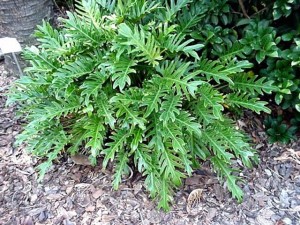
splitLeaf philodendron
Split Leaf Philodendron (bipennifolium) Sheath. The sheath is the casing for the actual leaf. As the leaf matures, it pulls away from the sheath, leaving it attached to the stem. It then turns a deep red brown with the texture of leather. The sheath is collected when the leaf has emerged and can be separated from the stem. Use it in twining, or as splints for weaving. It may be cut to shape or twine. Rehydrate for several hours if very dry. Do not repeat hydrate more than once. It can be used as an accent for decorative weaving.
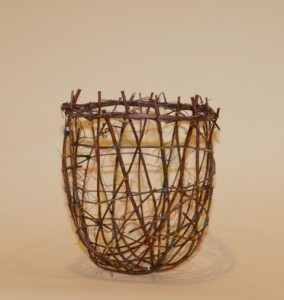 |
Fruit Branches, Apple, Plum, Apricot. Collect them when pruning trees in the spring. Make into circles for rims or use as spokes for rustic, appalachian style egg and melon baskets. |
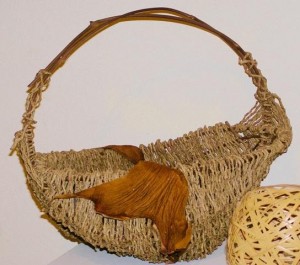 grape vine rims and split leaf sheath decorative accent |
Grape Vine Prune in winter or spring. Make rings for use as rims for above basket. Smaller vines may be used for weaving. |
Iris ( beardless, bearded) Rhizomes, bloom in the spring. Collect leaves when blooming is complete and leaves dry. Leaves may be pulled from base of the rhizome to prevent tearing of leaf. Leaves have a triangular shape and are yellow-brown in color. They are finely textured and create a lovely ticking pattern in the weaving. They are rehydrated for 1-2 hrs. for use in twining. Using Iris may discolor your hands, brown. It is not recommended to re-soak too often and it can be fragile.
 yellow iris |
 Iris by van Gogh |
Some examples of baskets using home grown and harvested natural materials.
 WINGED – a bird sculpture using date palm of the warp and triton for the weft. Accent of artificial sinew. |
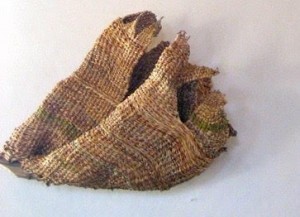 WAVES date palm,warp and tritonia, watsonia and gladiolus weavers |
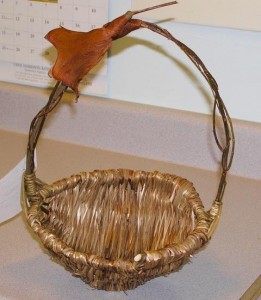
RUSTIC #3 apple branches with triton and decorative split leaf sheath
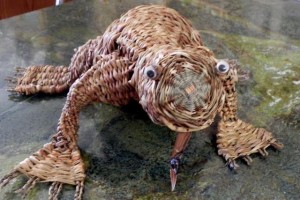
Frog sculpture woven for CNCH ‘o9 Date palm warp and watsonia, tritonia, and red hot poker weft
Every spring season I have a multicolored display of blossoms all over my yard. As the blooms fade I know it will be harvest time soon. In late summer and early fall the bounty must be collected before the rains begin. Rain will spot and mildew the leaves.
Usually the Tritonia is first to be ready, as it blooms the earliest. Bundles of the leaves are stored in the garage for re-hydrating and weaving during the winter or next spring. Watsonia is cut at the base, and also bundled.
Red Hot Poker is pulled at the bottom of the clump preserving the purple color on the leaf, which is a nice accent in weaving. Iris is collected in summer. Split leaf sheath is collected when a new leaf is fully expelled from it.
This year I have put in some willow. This is my first attempt at growing Salix. I obtained starts from Margaret Mathewson at CNCH 15. It will be years before I will be harvesting enough to use in basketry. Wish me luck.
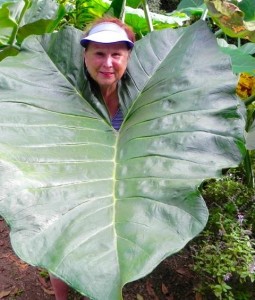
eugenia
Growing basketry materials affords me time in the garden, solitude for planning weavings, and fresh air. The heat of Sacramento can be daunting and timing is essential for the harvest. Every year the old unused materials are contributed to the green waste and replaced with the new materials. It is an ever evolving process. I enjoy it.